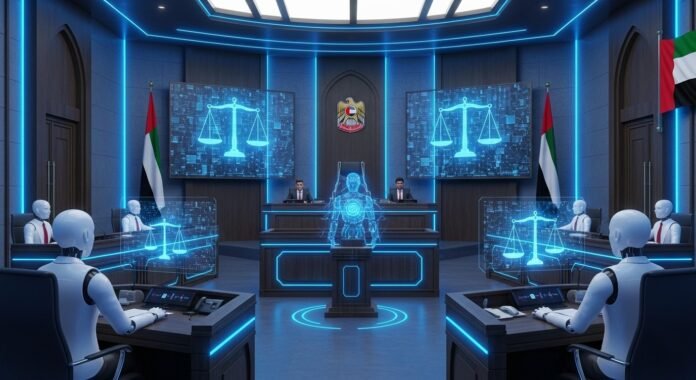The court of the future has been announced by the ministry of justice in United Arab Emirates (UAE).
Imagine walking into a courtroom with no papers, no lines, and no tapping your foot while waiting. No more towering, intimidating piles of paperwork and no more tired legal clerks processing your documents. Break from that wait. Greet a serene, ultra-modern landscape. Instead of waiting and frantically searching for your file, just look at a screen, your face is scanned, and soon, your entire case is there digitally managed, intelligently configured, and ready for action!
This is not a sci-fi movie. It is a glimpse into the Court of the Future showcased by the Ministry of Justice of the UAE at GITEX Global in Dubai. The Ministry aims for a radical transformation that includes a total integrated AI ecosystem: a digital ecosystem and the profound removal of paper, which currently dominates the presence of lawyers as we know them today.
The End of Paper and the Rise of AI Attorneys in the Court of the Future
A new, unprecedented radical transformation of judicial processes is underway, making them paperless, document-less, and lawyer-less… as in the new judicial processes, lawyers will no longer be needed. Unfortunately, this “Smart Justice” platform aims to enhance the entire litigation process to be faster, more logical, and intelligent. The entire vision is built around the Court of the Future concept.
A journey begins whenever a case is filed. The system uses facial recognition technology to identify the user and swiftly unlocks the user’s portal for secured access to the Ministry of Justice and Judicial Department. This reduces the long bureaucratic processes and identity verification steps.
However, the most interesting of the new innovations is in legal representation. The new system radically simplifies the process of assigning a lawyer and now takes less than a minute. Litigants are given two options, reflecting the Ministry’s balance of humanity and technology for the Court of the Future:
- Hire a real lawyer: The platform has an interactive list from which clients can pick a lawyer, pay a fee, and set up a virtual meeting after examining the profile containing the lawyer’s experience, credentials, and client reviews.
- Pick a virtual lawyer: This is the real difference. An AI attorney. This AI drafts legal briefs, smartly gathers and analyzes evidence, and remotely argues the case in court. The conversation capability is impressive, too. For countless people, the intricacy and cost of acquiring a real attorney serves as a huge obstacle to obtaining justice. An AI answer is quick, impartial, and very low-cost. This is a key part of the Future Court.
Smart Judge’s Bench: The Digital Core of the Court of the Future
This is the real difference. An AI attorney. This AI drafts legal briefs, smartly gathers and analyzes evidence, and remotely argues the case in court. The conversation capability is impressive, too. For countless people, the intricacy and cost of acquiring a real attorney serves as a huge obstacle to obtaining justice. An AI answer is quick, impartial, and very low-cost. This is a key part of the Future Court.
This platform also goes a step further in creating a draft judgment based on the objective facts and relevant case law the AI identifies. This technology does not remove the authority of the judge. As the Ministry of Justice stated, the judge retains control of all the proceedings, and the judge’s edits or independent judgment will replace the draft judgment the AI created. The vision for the Court of the Future is human-led.
The Ministry, through one of its spokespersons, clearly stated, and the simulation emphasized, that the vision to guide all stakeholders is ‘Innovative Digital Justice in Service of Humanity.’ The AI, a technological leap in judicial support, has taken over research and drafting, allowing the human judge to apply their expertise to the complex moral and factual issues a human can assess.
UAE’s Action on Upcoming Global Legal Systems: Defining the Court of the Future
The Ministry of Justice of the UAE aims to set a new worldwide standard for the flexibility and ease of use within the justice system, vis-a-vis the implementation of advanced technology, such as facial recognition, automated systems, and AI for drafting legal documents. No doubt the global legal system will have its concerns, but the intent is straightforward: to eliminate the system’s hold-ups and offer justice promptly and clearly.
Using new and advanced technology to block the Court of the Future allows the UAE to design and deliver justice around technology. The Court of the Future is no longer just a vision; it has become an ongoing reality.



